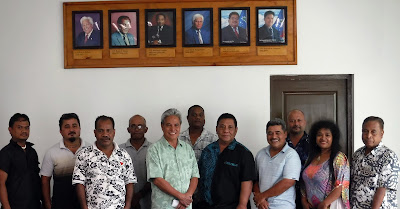Replicating Kitti with Participatory 3D Model Map
 | |
| Kitti community members with Nate Peterson and Michael Aulerio of TNC |
(Pohnpei, FSM)
The small island nations of Micronesia are jewels in the
Pacific Ocean. These tiny forested
islands, ringed by stunning lagoons and reefs are home to beautiful cultures
steeped in time and stories. Here in
Pohnpei, Federated States of Micronesia (FSM), The Nature Conservancy (TNC) and
the Conservation Society of Pohnpei (CSP) are working with local communities to
craft a three-dimensional map to highlight the significance of this stunning
landscape in the vast Pacific. The people
of Pohnpei are strongly tied to both the ocean and the land. They rely equally on the ocean to provide
marine resources and the land for food and shelter.
This Participatory 3D Model (P3DM) of Kitti Municipality on
the southwest corner of Pohnpei provides a clear picture of the area from the
top of the ridges to the outer barrier reef.
With this scale model (1:7,500) all members of the community, leaders,
and those lucky enough to visit, will quickly and easily understand the
connection from ridge to reef. It
provides a focal point for discussions on how the land and sea are being used,
and importantly, how to plan for the future.
A key feature of the P3DM development process is that it encourages
greater dialogue and coordination between government and communities. Topics
that can be discussed around the model include runoff from the hills to the
reef resulting in sedimentation; the role of mangroves for protecting the
shoreline; and how protected areas are connected (or not!). Across these and other issues the foundation
is equality for everyone to have an understanding and voice about the future of
Pohnpei.
The P3DM workshop began on Monday 29 October and will be
completed in two weeks, Friday 9 November.
During the first week we build the blank model reaching the island high
point at 2,600 feet. The second week is
then the time to populate the model by painting the reefs and forest, marking
trails and boundaries with strings, and point locations with pins and labels. At the end we place a legend and reference
map so that users can easily interpret the symbols. The features on the map will also be
transferred into a geographic information system (GIS) so the valuable
information can be incorporated with other data sets. As the model will stay here in Kitti it can
continue to be used for planning, education, and decision making.
In 2017 our team completed a P3DM for the municipality of
U. Now with this one for Kitti, and the
training provided to CSP staff and residents of Pohnpei, it would be fantastic
to build a P3DM for Madolenihmw, Sokehs and Nett municipalities as well.
We extend our thanks and recognition to the FSM
Ridge to Reef Project, funded by the Global Environment Facility
through the United Nations Development Programme and of course the community of Kitti for their
enthusiasm to construct THEIR map of Kitti.






